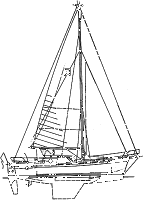NOLS 36
Classroom cruiserr
I was given such a challenge when I was approached by George Van Sickle of the National Outdoor Leadership School. The school had previously chartered Catalinas in the San Juans for its sailing courses, but George felt the Catalinas did not reflect the philosophy of the school. George wanted to train his students in sailing, not in "yachting."
George's idea of a cruise is to gunkhole the coast of Patagonia in an open boat. My idea of the ideal NOLS boat was a boat based upon Northwest workboat aesthetics, rugged and purposeful in its style. We chose an aluminum hull, finished to be natural, rugged and simple in its details. I think we came up with a uniquely handsome boat. My vision was to walk the students through the marina, past the shiny, plain, white sloops and present them with a boat that was obviously different and reflected the philosophy of NOLS.
The hull form uses a single chine for building simplicity. Chines (corners) don't have to be ugly. If the chine line is developed with sensitivity, it can add to the beauty of the boat and accentuate the lines. The D/L is 228, making this a moderate-displacement boat capable of floating robust scantlings. The ends are short with no overhang aft at all. I chose an outboard rudder because I like the look and it lends itself to tiller steering. The topsides are flared to avoid a slab-sided look. When hauled, the keel is big enough to stand the boat on without concern.
The interior was a challenge. NOLS required berths for six students and an instructor. I chose settee berths with fold-up, seat-back pilot berths in the main cabin. The V-berths will also be pipe berths. A diesel-fueled galley stove will provide warmth in the fall. The instructor will have the comfortable quarter berth. There is standing headroom throughout the main cabin but not forward. Privacy was not an issue.
The deck is very simple in its layout. We will use a small companionway dodger only, and this allows us to keep the traveler aft on the bridgedeck. The wide cockpit seats will be ideal for sleeping in balmy weather. Side decks are broad and the flush deck forward will make sail handling easy. The bowsprit is an A-frame type that gets the anchors well forward of the stem. There will be no windlass. A 4-inch bulwark will work better than the typical extruded 1.5-inch "trip strip." The deck camber will be exaggerated a bit to help with headroom forward.
The rig incorporates a genoa with no roller furling and a staysail for heavy air. The staysail will sheet inside the shrouds. The SA/D is 17.3. Halyards will all be on the mast.
This boat will be ruggedly built with 3/16-inch plating above the chine and 1/4-inch plating below. The skin will be supported by frames and longitudinals. The keel will be aluminum with internal lead ballast. At the time of this writing, we are unsure whether we will go with the sail drive or a shaft and strut installation.
As I drew this boat, I began to wonder if more people would not like a simple and straightforward boat like this. It's not a yacht. It's a sailboat with an aesthetic dynamic that sets it apart. This boat is a classroom for ocean wilderness education.

Comments